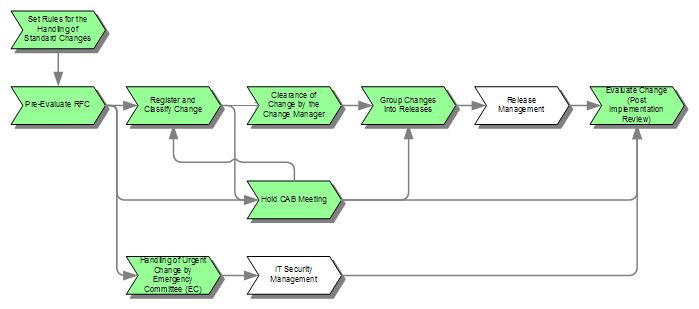Change Management - ITIL V2

ITIL Version: ITIL V2 → see also Change Management - ITIL V3
Process-Objective: In Change Management, all Changes to the IT infrastructure and its components (Configuration Items) are authorized and documented, in order to ensure that interruptive effects upon the running operation are kept to a minimum. The implementation steps are planned and communicated, in order to recognize potential side-effects as early as possible. The Change Manager and (for further-reaching Changes) the Change Advisory Board (CAB) bear the responsibility for this. A specific procedure is in existence for emergencies, dealing with Urgent Changes.
Part of: Service Support
Process Owner: Change Manager
Sub-Processes

Set Rules for the Handling of Standard Changes
- Process objective: Rules are to be set that define explicitly for the IT organization, which Changes are allowed to be implemented without being subjected to the Change Management Process. For this purpose it is also determined, how these Changes ("Standard Changes") are handled.
Pre-Evaluate RFC
- Process objective: It is to be ensured, that only RFC which are in accordance with the defined quality requirements are accepted into the Change Management Process.
Register and Classify Change
- Process objective: Registration and categorisation of RFCs/ Changes, so that only documented RFCs gain access into the process and are assigned to the correct and appropriate body (Change Manager, CAB, or EC).
Clearance of Change by the Change Manager
- Process objective: Clearance or rejection of a Change as well as preliminary scheduling and incorporation into the FSC (Forward Schedule of Changes).
Hold CAB Meeting
- Process objective: Clearance or rejection of a Change, in addition to preliminary scheduling and incorporation into the FSC (Forward Schedule of Changes).
Group Changes into Releases
- Process objective: Approved Changes are to be grouped into Releases; the clearance for the Rollout is to be issued by Change Management.
Evaluate Change (Post Implementation Review)
- Process objective: Appraisal of the process and the results of the Change-implementation, so that a complete documentation is present for later reference and lessons may be learnt from any mistakes.
Handling of Urgent Change by Emergency Committee (EC)
- Process objective: Quickest possible clearance or rejection of an Urgent Change, which is to serve to fight an emergency.
Involved Roles
- Change Advisory Board
- Change Manager
- Configuration Manager
- Emergency Committee (EC): The Emergency Committee represents the body for the approval of changes in emergencies which, due to their urgency, do not allow an orderly convening of the CAB. It is convened by the Change Manager or his representative for emergencies, whereby the constitution is determined by each individual situation. In order that the EC is definitely in a position to act in an emergency, rules for availability and temporary replacements must be reached with the members.
- Release Manager






